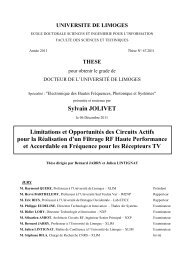Contribution à la conception optimale en terme de linéarité et ...
Contribution à la conception optimale en terme de linéarité et ...
Contribution à la conception optimale en terme de linéarité et ...
You also want an ePaper? Increase the reach of your titles
YUMPU automatically turns print PDFs into web optimized ePapers that Google loves.
CHAPITRE II – CONSIDERATIONS GENERALES SUR LA LINEARITE DES AMPLIFICATEURS DE PUISSANCE<br />
Puissance <strong>de</strong>s produits d’intermodu<strong>la</strong>tion d’ordre 3 du type 2f -f<br />
1 2<br />
3<br />
a<br />
4<br />
3<br />
⎛ 2Pti<br />
⎜<br />
⎝ n<br />
3<br />
⎞<br />
⎟<br />
⎠<br />
a<br />
+ 105<br />
a<br />
/ 2<br />
7<br />
3<br />
⎛<br />
⎜<br />
⎝<br />
⎡ 2<br />
⎢1<br />
+<br />
⎣ 3<br />
Pti<br />
n<br />
2<br />
⎞<br />
⎟<br />
⎠<br />
a<br />
a<br />
⎧<br />
⎨<br />
⎩<br />
5<br />
3<br />
⎛ Pti ⎞<br />
⎜ ⎟<br />
⎝ n ⎠<br />
{ 12.<br />
5 + 15(<br />
n − 2)<br />
}<br />
13<br />
6<br />
( n − 2)(<br />
n − 3)<br />
+ ( n − 2)<br />
+<br />
7 ⎫<br />
⎤<br />
⎬ + L⎥<br />
12⎭<br />
⎥⎦<br />
Puissance <strong>de</strong>s produits d’intermodu<strong>la</strong>tion d’ordre 3 du type f +f -f<br />
1 2 3<br />
3<br />
a<br />
2<br />
3<br />
⎛ 2Pti<br />
⎜<br />
⎝ n<br />
3<br />
⎞<br />
⎟<br />
⎠<br />
/ 2<br />
⎡ a<br />
⎢1<br />
+ 10<br />
⎣ a<br />
a<br />
+ 210<br />
a<br />
7<br />
3<br />
5<br />
3<br />
⎛ Pti ⎞⎧3<br />
⎜ ⎟⎨<br />
+<br />
⎝ n ⎠⎩2<br />
⎛<br />
⎜<br />
⎝<br />
Pti<br />
n<br />
2<br />
⎞<br />
⎟<br />
⎠<br />
⎧ 7<br />
⎨1<br />
+<br />
⎩ 4<br />
( n − 3)<br />
⎫<br />
⎬<br />
⎭<br />
1<br />
2<br />
( n − 3)<br />
+ ( n − 3)(<br />
n − 4)<br />
Puissance <strong>de</strong>s produits d’intermodu<strong>la</strong>tion d’ordre 5 du type 3f -2f<br />
1 2<br />
5<br />
a<br />
8<br />
5<br />
⎛ 2Pti<br />
⎜<br />
⎝ n<br />
5<br />
⎞<br />
⎟<br />
⎠<br />
/ 2<br />
⎡ 49<br />
⎢1<br />
+<br />
⎣ 4<br />
a<br />
a<br />
7<br />
5<br />
⎛ Pti ⎞⎧<br />
12<br />
⎜ ⎟⎨1<br />
+<br />
⎝ n ⎠⎩<br />
7<br />
⎫<br />
⎤<br />
( n − 2)<br />
⎬ + L⎥<br />
⎭ ⎦<br />
⎫<br />
⎤<br />
⎬ + L⎥<br />
⎭ ⎥⎦<br />
Dans le cas où les porteuses sont uniformém<strong>en</strong>t réparties (écart fréqu<strong>en</strong>tiel fixe <strong>en</strong>tre<br />
chaque porteuse), les produits d’intermodu<strong>la</strong>tion issus <strong>de</strong>s distorsions d’ordre impair<br />
coïncid<strong>en</strong>t avec les porteuses. Le nombre <strong>de</strong> produits tombant sur chaque porteuse dép<strong>en</strong>d <strong>de</strong><br />
l’ordre <strong>de</strong> <strong>la</strong> distorsion <strong>et</strong> du nombre <strong>de</strong> porteuses.<br />
Le nombre <strong>de</strong> produits d’intermodu<strong>la</strong>tion d’ordre 3 du type 2f1-f tombant sur <strong>la</strong> r ème<br />
2<br />
porteuse est :<br />
r 1 ⎡ 1 n r ⎤<br />
D n = ⎢n<br />
− 2 − { 1−<br />
( −1)<br />
}( −1)<br />
2<br />
⎥⎦<br />
⎣ 2<br />
porteuse est :<br />
Le nombre <strong>de</strong> produits d’intermodu<strong>la</strong>tion d’ordre 3 du type f1+f2-f tombant sur <strong>la</strong> r ème<br />
3<br />
r<br />
Dn<br />
=<br />
r<br />
2<br />
1<br />
4<br />
[ n − r + 1]<br />
+ ( n − 3)<br />
2 1<br />
[ − 5]<br />
− 1−<br />
( −1)<br />
n n + r<br />
[ ][ −1]<br />
8<br />
Ces résultats perm<strong>et</strong>t<strong>en</strong>t l’analyse du fonctionnem<strong>en</strong>t faiblem<strong>en</strong>t non-linéaire d’une<br />
non-<strong>linéarité</strong> sans mémoire <strong>en</strong> fonction du nombre <strong>de</strong> porteuses.<br />
52
















